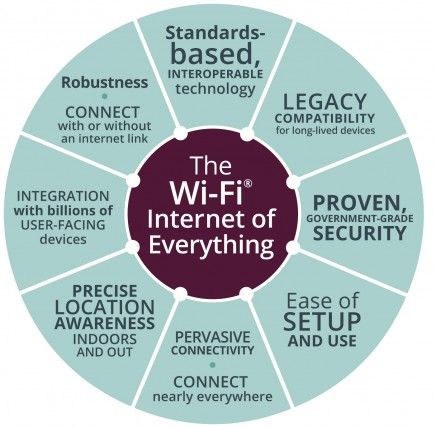Wi-fi connects things to one another and links those objects back to the user-facing devices people already have to enjoy and manage their lives. As the pace of innovation in electronics continues to accelerate and as the universe of connected devices explodes, wi-fi will become more useful than ever. For the internet of everything (IoE) to realise its tremendous potential, a number of disparate elements must come together in a powerful symphony. Several key components will align to form a foundation for innovation and enable the network effects upon which a fully realised IoE depends.
STANDARDS-BASED INTEROPERABLE TECHNOLOGY
The IoE will be powered by open, available, industry-standard technologies. The market must have confidence that devices and systems will be able to connect, regardless of product brand. Standards-based wi-fi is interoperable technology – its broad industry support and the Wi-Fi CERTIFIED™ logo programme have been key factors in the technology’s massive success.
LEGACY COMPATIBILITY
A defining characteristic of the IoE is the longevity of many of the devices deployed. Refrigerators, sprinkler systems, parking meters, automotive telematics and enterprise monitoring systems cannot be replaced every year or two to adapt to changing technology. Over the past 15 years, the wi-fi industry has brought forth a number of significant performance upgrades, while preserving backwards compatibility.
SECURITY
With sensitive government, industrial and personal applications connected to the IoE, industry-standard, proven, tested security will be critical to success. Every wi-fi device certified today includes WPA2 security, with government-grade advanced encryption standard and a range of proven user authentication mechanisms.
EASE OF DEPLOYMENT AND USE
Particularly in consumer applications, IoE adoption depends on ease of use. Devices must be easy to enable and connect with little or no technical knowledge, and they must be virtually maintenance free. Some IoE devices will be stationary, while others will be mobile and need to connect seamlessly in many different nodes. The wi-fi industry has developed technologies to simplify device pairing, network authentication and more.

PERVASIVE CONNECTIVITY
The reach of IoE depends upon widely available connectivity for home and mobile applications alike. The hundreds of millions of homes and millions of wi-fi hotspots deployed today, and in the future plans of municipalities, transit systems and service- provider footprints, mean that IoE devices will rarely lack for an available connection.
LOCATION AWARENESS
Given the vast number of home, enterprise and public wi-fi networks, wi-fi access points are easily found in virtually all public locations. Of all connectivity technologies in the IoE space, wi-fi is able to deliver the most precise indoor location data for user devices and this enables a range of IoE location-aware services.
INTEGRATION WITH EXISTING TECHNOLOGY
IoE systems will interact with all the user-centric wi-fi devices in use today, including smartphones and tablets, computing and peripherals, and home entertainment systems. Consumers, in particular, expect to integrate all connected devices on a single home network – specifically on wi-fi.
ROBUSTNESS
The advanced capabilities enabled by internet control of devices must not come at the expense of an increased susceptibility to failure modes. The connectivity technologies in use must be reliable and robust, even in disaster scenarios, and connectivity for emergency control must be available for mission-critical devices when internet access is disrupted.
